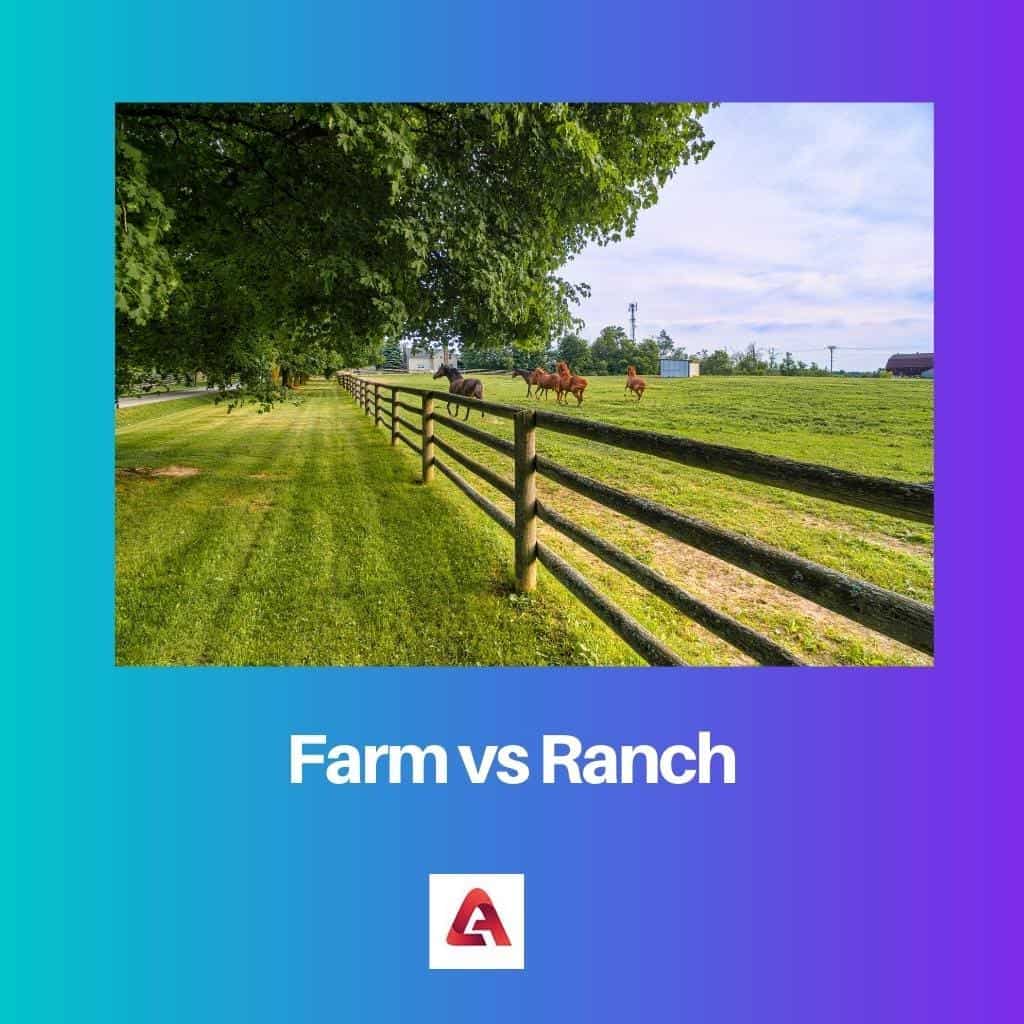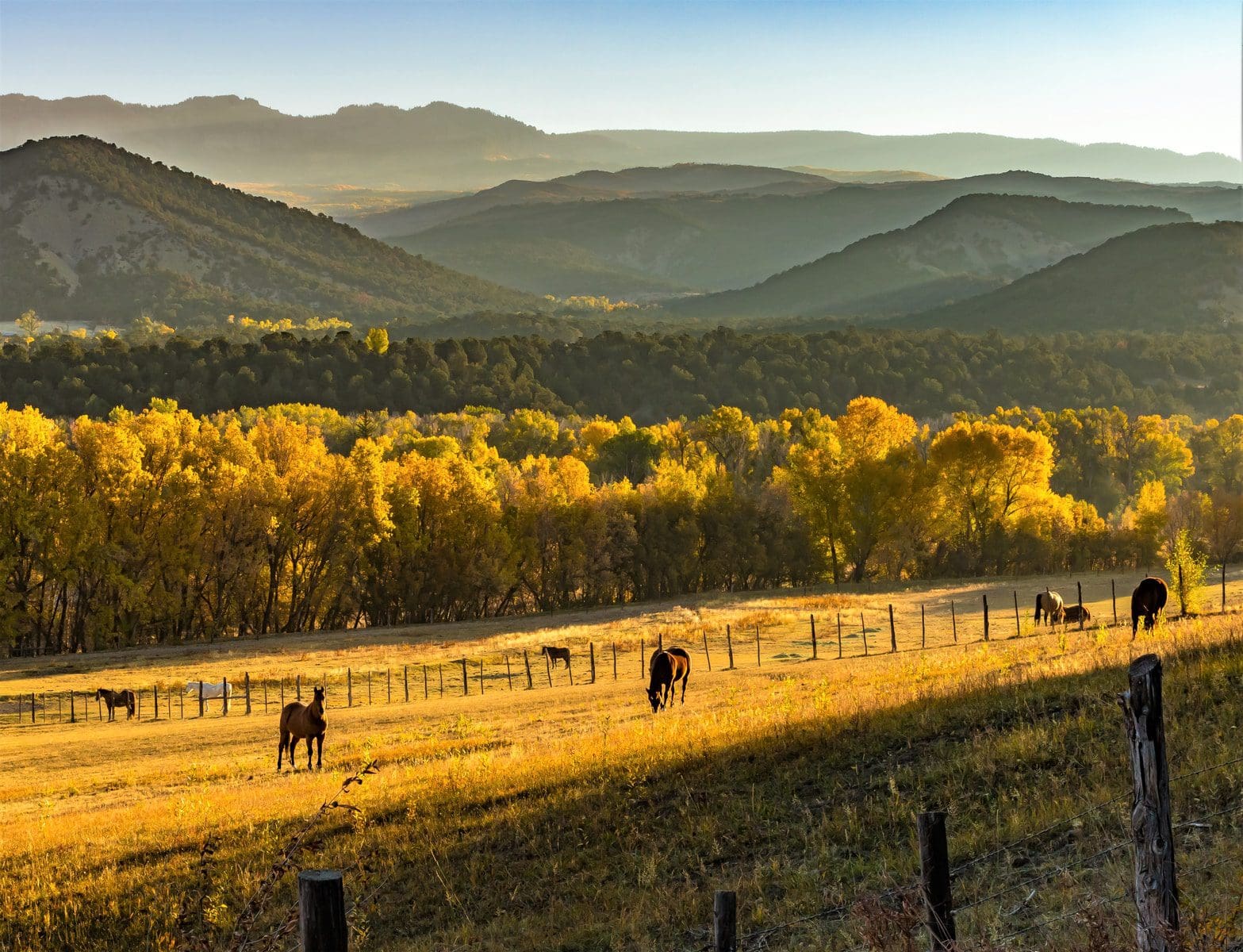A farm refers to a smaller agricultural operation focused on cultivating crops, raising livestock, or both, for subsistence or local markets. In contrast, a ranch denotes a larger-scale enterprise primarily dedicated to raising livestock, particularly cattle, sheep, or horses, across vast expanses of land, with a focus on grazing and animal husbandry.
Key Takeaways
- Farm refers to a piece of land used for agricultural production, including crops and livestock.
- A ranch refers to a large farm that raises grazing animals, such as cattle or sheep.
- Farms are more diverse regarding crops and livestock, while ranches focus on grazing animals and livestock management.
Farm vs Ranch
A farm is a piece of land used to produce crops, livestock, or other agricultural products, including fields for growing crops and pastures for grazing animals. A ranch is a large farm or agricultural operation specialising in raising livestock, especially cattle, sheep, or horses.

However, people confuse the two even if the words are different. A farm is an area of land primarily devoted to agriculture.
Farming land only produces food crops and other kinds of vegetables.
On the other hand, a ranch is supposed to mean an area of land where the ranchers do the practice of grazing livestock.
A ranch brings in meat and other non-vegetarian items to the market.
Comparison Table
| Feature | Farm | Ranch |
|---|---|---|
| Primary Focus | Cultivating crops and/or raising livestock for meat, dairy, or other products | Raising livestock for meat, wool, or other products |
| Land Use | Smaller and more diverse, with fields, pastures, and sometimes greenhouses | Larger and primarily composed of pastures or rangeland |
| Products | Crops (fruits, vegetables, grains), livestock (cattle, pigs, poultry), eggs, dairy products | Livestock (cattle, sheep, goats, horses) |
| Farming Practices | Intensive cultivation and management, involving tilling, planting, and irrigation | Extensive grazing, with minimal intervention in the natural environment |
| Equipment | Tractors, harvesters, plows, irrigation systems | Trucks, ATVs, horses, herding dogs |
| Typical Size | Varies, but smaller than ranches (10-100 acres) | Typically larger than farms (hundreds to thousands of acres) |
| Labor Requirements | More labor-intensive due to crop cultivation and management | Less labor-intensive due to reliance on natural grazing |
| Environmental Impact | Can have a higher impact due to land clearing, tilling, and potential use of fertilizers and pesticides | Generally has a lower impact, but overgrazing can be a concern |
What is a Farm?
A farm is an agricultural establishment where various activities related to the cultivation of crops, the raising of livestock, or both are carried out. Farms play a crucial role in food production, supplying a wide range of agricultural products to markets, communities, and industries.
Key Elements of a Farm
1. Agricultural Cultivation:
- Farms are primarily engaged in the cultivation of crops, ranging from grains, fruits, and vegetables to specialty crops like herbs and spices.
- Cultivation practices include planting, nurturing, and harvesting crops using a variety of techniques such as mechanized farming, organic farming, or hydroponics.
- Crop selection depends on factors like soil type, climate, market demand, and the expertise of the farmer.
2. Livestock Rearing:
- Many farms also incorporate livestock rearing as part of their operations, raising animals for meat, dairy, eggs, wool, or other products.
- Livestock commonly found on farms include cattle, pigs, poultry, sheep, goats, and occasionally exotic animals depending on regional and cultural preferences.
- Farming practices for livestock encompass breeding, feeding, housing, healthcare, and management to ensure the health and productivity of the animals.
3. Diversified Activities:
- Farms engage in diversified activities beyond crop cultivation and livestock rearing, such as agroforestry, aquaculture, beekeeping, or agritourism.
- Diversification can enhance farm resilience, income stability, and environmental sustainability by leveraging complementary agricultural practices and income streams.
- Integrated farming systems, where multiple agricultural activities are synergistically combined, are increasingly popular for maximizing resource efficiency and profitability.
4. Role in Food Supply:
- Farms are fundamental to food supply chains, producing the raw ingredients that form the basis of various food products consumed locally, nationally, and globally.
- They contribute to food security by ensuring a steady supply of nutritious food items, reducing dependence on imports, and promoting self-sufficiency in agricultural production.
- Sustainable farming practices, including organic farming, regenerative agriculture, and permaculture, are gaining prominence to address environmental concerns and promote long-term food system resilience.

What is a Ranch?
A ranch is a large agricultural property primarily dedicated to the raising of livestock, particularly cattle, sheep, or horses. Ranching operations involve extensive grazing land, specialized facilities, and management practices tailored to the needs of the livestock being raised.
Key Elements of a Ranch
1. Livestock Focus:
- Ranches are characterized by their emphasis on livestock production, with cattle being the most common livestock raised. However, sheep, goats, horses, and other animals may also be part of ranching operations.
- Livestock on ranches are raised for meat, dairy, fiber (such as wool), or as working animals (e.g., ranch horses). Breeding, feeding, and healthcare are essential aspects of ranch management to ensure the health and productivity of the animals.
2. Extensive Grazing Land:
- Ranches encompass vast expanses of land, measured in hundreds or thousands of acres, where livestock graze freely.
- Grazing land may consist of natural pasture, rangeland, or cultivated forage crops specifically grown to support the nutritional needs of the animals.
- Adequate land resources are essential for sustaining livestock populations, preventing overgrazing, and preserving the natural ecosystem balance.
3. Infrastructure and Facilities:
- Ranches require specialized infrastructure and facilities to support livestock management and operations. This may include:
- Fencing to delineate grazing areas and manage herd movements.
- Water sources such as ponds, streams, wells, or water troughs to provide drinking water for livestock.
- Livestock handling facilities, such as corrals, chutes, and sorting pens, for activities like vaccination, branding, or shipping.
- Shelter structures, such as barns or sheds, for protection from extreme weather conditions.
4. Ranch Management Practices:
- Ranch management involves a range of activities aimed at optimizing livestock health, productivity, and land stewardship:
- Rotational grazing strategies to maximize forage utilization, minimize soil erosion, and promote pasture health.
- Genetic selection and breeding programs to improve livestock traits such as growth rate, meat quality, or disease resistance.
- Range management practices to preserve biodiversity, prevent soil degradation, and conserve natural resources.
- Financial planning, marketing, and risk management strategies to ensure the economic viability and sustainability of the ranching operation.

Main Differences Between Farm and Ranch
- Livestock Focus:
- Farms: May incorporate livestock alongside crop cultivation but have a more diversified focus.
- Ranches: Primarily dedicated to raising livestock, with cattle being most common, across extensive grazing lands.
- Land Size and Use:
- Farms: Generally smaller in size, with land used for crop cultivation, pasture, and other agricultural activities.
- Ranches: Typically encompass vast expanses of land, primarily used for grazing livestock, measured in hundreds or thousands of acres.
- Infrastructure and Facilities:
- Farms: Infrastructure may include barns, silos, and irrigation systems to support crop production, alongside facilities for livestock if present.
- Ranches: Specialized infrastructure such as fencing, water sources, and livestock handling facilities designed for extensive grazing and livestock management.
- Management Practices:
- Farms: Management practices vary depending on crops grown, with a focus on planting, harvesting, and crop rotation, along with livestock care if applicable.
- Ranches: Management revolves around livestock care, breeding, grazing management, and range conservation practices to maintain the health of both animals and land.
- Economic Focus:
- Farms: Often involved in diverse agricultural activities, including crop sales, livestock products, and potentially agritourism or value-added products.
- Ranches: Primary income source comes from the sale of livestock and livestock products, with a focus on efficient grazing land management.
- Environmental Impact:
- Farms: Environmental impacts may vary depending on farming practices, including pesticide use, soil management, and water usage.
- Ranches: Environmental impacts revolve around grazing land management, soil conservation, and habitat preservation for wildlife species.




